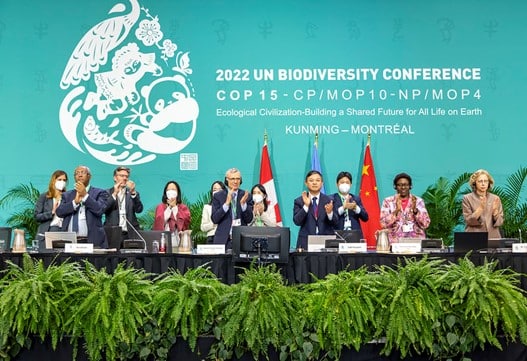In December 2022, the 15th Conference of the Parties (COP15) to the United Nations Convention on Biological Diversity was held in Montréal with a focus on protecting nature and halting biodiversity loss around the world. As a result, delegates agreed to the landmark Kunming-Montréal Global Biodiversity Framework.
Targets and Goals
In an effort to safeguard nature and halt and reverse biodiversity loss, the Kunming-Montréal Global Biodiversity Framework includes 4 goals and 23 targets for achievement by 2030. Since producers, ranchers, and landowners will play an active role in making these goals a reality by 2030, the Pinion sustainability team has broken down the key items you need to know.

Global targets for 2030:
Of the 23 targets established, a few key targets include:
- Protecting 30% of Earth’s lands, oceans, coastal areas, and inland waters.
- Ensuring that agricultural land is managed sustainably through the implementation of biodiversity-friendly practices, including innovative approaches to increase resilience, efficiency, and productivity.
- Mobilizing at least $200 billion per year from public and private sources for biodiversity-related funding.
- Requiring large multinational companies and financial institutions to monitor, assess, and transparently disclose their risks, dependencies, and impacts on biodiversity.
- Cutting global food waste in half.
Why act on biodiversity?
Biodiversity is critical to building resiliency in our food systems. Benefits of biodiversity include “safeguarding global food security, underpinning healthy and nutritious diets, improving rural livelihoods, and enhancing the resilience of people and communities,” said José Graziano da Silva, Director General of the Food and Agriculture Organization of the United Nations (FAO).
“Less biodiversity means that plants and animals are more vulnerable to pests and diseases. Compounded by our reliance on fewer and fewer species to feed ourselves, the increasing loss of biodiversity for food and agriculture puts food security and nutrition at risk,” added Graziano da Silva.
What does this mean for farmers, processors, and agribusiness?
Farmers, processors, and agribusinesses will be integral to achieving the goals outlined in COP15. Although there are no current overarching guidelines for meeting these goals, we anticipate that quantifying biodiversity impacts will become standard for many businesses.
It should be noted that the goals outlined in COP15 are not legally binding, but in much the same way the Paris Agreement goals have become the standard for businesses in making greenhouse gas reductions, the COP15 goals are expected to set the standard for private sector biodiversity preservation and restoration.
How to Get Started
If you’re considering evaluating the impact of your organization or value chain on biodiversity, now is a great time. Reach out to our sustainability advisors to discuss your company’s sustainability objectives and how to drive progress.










